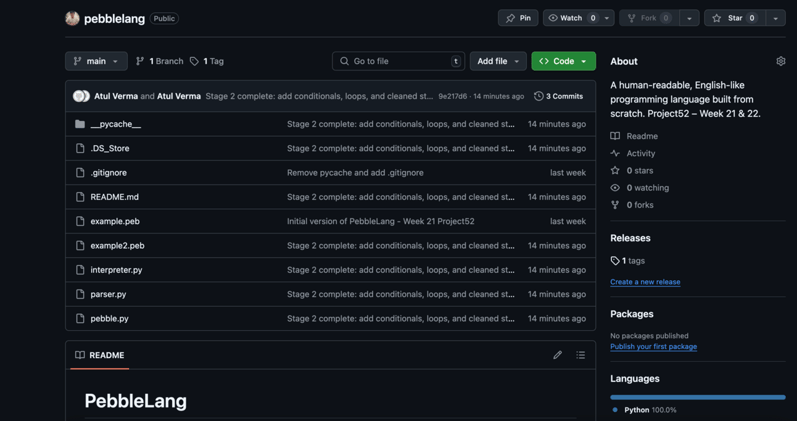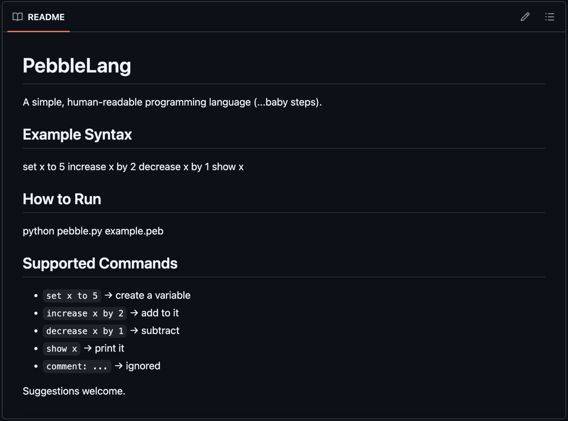
I Taught My Programming Language to Think in Blocks
In Week 22 of Project52, I evolved PebbleLang from a flat, single-line interpreter into a structured, block-aware language by adding support for conditionals and loops. This meant rewriting the parser to detect and group if ... then ... end and repeat ... times: ... end blocks, and updating the interpreter to evaluate nested logic. With these additions, PebbleLang can now make decisions and repeat actions - core capabilities of any real programming language. While still minimal, this version introduces control flow, making the language feel far more expressive and complete.

I Built a Programming Language from Scratch
PebbleLang is a minimalist, human-readable programming language built entirely from scratch using Python. Designed to feel more like natural language than code, it lets you write commands like set x to 5 and increase x by 3 instead of traditional syntax. The goal was to explore the foundations of programming by creating a fully working parser and interpreter that anyone can read, understand, and modify - even without prior experience building languages.
I made this donut stack from scratch (in Blender)
For Week 20 of Project52, I stepped away from code and entered the world of 3D modeling - opening Blender for the very first time. Following Blender Guru’s iconic donut tutorial, I built a fully rendered donut stack from scratch, learning everything from mesh modeling and texture painting to lighting, shading, and final rendering. What started as a beginner’s experiment quickly became an immersive deep dive into visual storytelling, design logic, and the surprisingly technical world of 3D creation.
Building a RAG-Powered AI ChatBot from Scratch
This Project52 build was a deep dive into creating a fully functional, multi-tenant AI chatbot platform using Retrieval-Augmented Generation (RAG). The goal: allow any business to train a chatbot on their internal documents, deploy it publicly, and capture leads all while keeping their data completely isolated and secure. We built everything from scratch including user authentication, lead classification, file-based knowledge ingestion, and admin dashboards combining FastAPI, LangChain, SQLite/PostgreSQL, and a custom React frontend. This wasn’t just a chatbot; it was the foundation for a scalable SaaS product that gives each business its own smart assistant.
Tic Tac Toe with AI Logic and Glassmorphic Design
For Week 18 of Project52, I rebuilt Tic Tac Toe from the ground up, not as a basic JavaScript exercise, but as a design-forward, logic-rich browser game. The goal was to blend classic gameplay with modern frontend principles: responsive layout, intuitive state management, and AI-driven interaction. The final version supports both Player vs Player and Player vs Bot modes, with the bot intelligently blocking player wins. Visually, it features a polished glassmorphic interface, subtle animations, and color-coded feedback all contained within a single HTML file, no frameworks or libraries required.
Archive

I built Design Daily - A Marketplace for Basic UI Components
In Week 23 of Project52, I have built Design Daily.Design Daily is a growing collection of handcrafted UI components built with clean HTML, CSS, and a focus on usability. From buttons and forms to cards and modals, every element is designed to be copy-paste ready, framework-free, and easy to integrate into any project.Whether you're a developer looking to save time or a designer seeking inspiration, Design Daily offers a curated library of essential building blocks with plans to evolve into a full marketplace for creators and teams alike.


I Taught My Programming Language to Think in Blocks
In Week 22 of Project52, I evolved PebbleLang from a flat, single-line interpreter into a structured, block-aware language by adding support for conditionals and loops. This meant rewriting the parser to detect and group if ... then ... end and repeat ... times: ... end blocks, and updating the interpreter to evaluate nested logic. With these additions, PebbleLang can now make decisions and repeat actions - core capabilities of any real programming language. While still minimal, this version introduces control flow, making the language feel far more expressive and complete.


I Built a Programming Language from Scratch
PebbleLang is a minimalist, human-readable programming language built entirely from scratch using Python. Designed to feel more like natural language than code, it lets you write commands like set x to 5 and increase x by 3 instead of traditional syntax. The goal was to explore the foundations of programming by creating a fully working parser and interpreter that anyone can read, understand, and modify - even without prior experience building languages.


I made this donut stack from scratch (in Blender)
For Week 20 of Project52, I stepped away from code and entered the world of 3D modeling - opening Blender for the very first time. Following Blender Guru’s iconic donut tutorial, I built a fully rendered donut stack from scratch, learning everything from mesh modeling and texture painting to lighting, shading, and final rendering. What started as a beginner’s experiment quickly became an immersive deep dive into visual storytelling, design logic, and the surprisingly technical world of 3D creation.


Building a RAG-Powered AI ChatBot from Scratch
This Project52 build was a deep dive into creating a fully functional, multi-tenant AI chatbot platform using Retrieval-Augmented Generation (RAG). The goal: allow any business to train a chatbot on their internal documents, deploy it publicly, and capture leads all while keeping their data completely isolated and secure. We built everything from scratch including user authentication, lead classification, file-based knowledge ingestion, and admin dashboards combining FastAPI, LangChain, SQLite/PostgreSQL, and a custom React frontend. This wasn’t just a chatbot; it was the foundation for a scalable SaaS product that gives each business its own smart assistant.


Tic Tac Toe with AI Logic and Glassmorphic Design
For Week 18 of Project52, I rebuilt Tic Tac Toe from the ground up, not as a basic JavaScript exercise, but as a design-forward, logic-rich browser game. The goal was to blend classic gameplay with modern frontend principles: responsive layout, intuitive state management, and AI-driven interaction. The final version supports both Player vs Player and Player vs Bot modes, with the bot intelligently blocking player wins. Visually, it features a polished glassmorphic interface, subtle animations, and color-coded feedback all contained within a single HTML file, no frameworks or libraries required.


NEON SERPENT - Reimagining the Snake Game in Glowing Retro Futurism
Neon Serpent is a fully reimagined version of the classic Snake game, crafted from scratch using only HTML, CSS, and JavaScript in a single file.It blends retro nostalgia with futuristic aesthetics: glowing neon visuals, pulsing animations, mobile responsiveness, and particle effects all come together to create an immersive, arcade-inspired browser experience.


EvenSteven: How I Engineered a Private, Simple & Framework-Free Bill Splitter
EvenSteven is a fast, privacy-first web application that makes splitting expenses simple, fair, and visually seamless - without requiring any login, server, or external dependencies. Designed as a fully client-side single-page app, it handles everything from equal splits to complex custom contributions across multiple currencies. With a clean tab-based interface, smart settlement logic, and a responsive dark-theme UI, EvenSteven runs entirely in your browser, processes all data locally, and is optimized for both desktop and mobile (including one-handed mode). It’s a professional-grade tool built with pure HTML, CSS, and JavaScript proving you don’t need a backend or a bloated framework to deliver a powerful user experience.


Watching the Internet Talk: A Beginner’s Packet Sniffer in Python
In this project, I built a lightweight packet sniffer using Python and the Scapy library to capture and inspect live network traffic at the transport and network layers. The goal was to understand, from first principles, how data flows through a system when it connects to the internet. By parsing IP, TCP, UDP, and ICMP packets in real-time, the tool reveals exactly who your machine is talking to, over which ports and protocols, and at what stage of communication—handshake, data transfer, or teardown. It’s a raw, low-level window into the internet’s pulse, built entirely from scratch for educational exploration.


Writing a Minimal OS Loader That Boots into 32-Bit Mode
In this week’s Project52 build, I wrote a 512-byte boot sector that does far more than just boot — it switches the CPU into 32-bit Protected Mode, clears the screen, and prints a message without relying on BIOS or any operating system. This project builds directly on last week’s real-mode bootloader by going deeper into how modern systems actually start up. Instead of using BIOS interrupts like int 0x10, it sets up its own Global Descriptor Table (GDT), flips the protection bit in the CPU’s control register, and writes directly to VGA memory at 0xB8000. It’s a foundational leap from "printing in real mode" to "owning the machine in protected mode."


Writing a 512-Byte Boot Sector OS in x86 Assembly from Scratch
In Week 12 of Project52, I challenged myself to build an operating system from the most fundamental entry point possible: the boot sector. This 512-byte region at the start of a disk is the first code executed by the CPU after power-on, loaded directly into memory by the BIOS. Without relying on GRUB, Linux, or even a file system, I wrote hand-crafted x86 Assembly that runs in 16-bit real mode, interacts with BIOS interrupts, and produces output directly to the screen. This project was an exercise in minimalism, precision, and understanding the bare-metal mechanics of how all modern computing systems begin.

